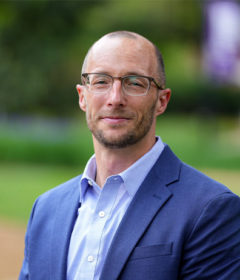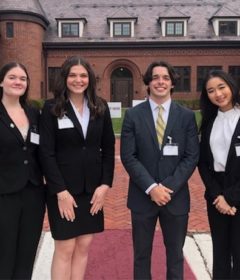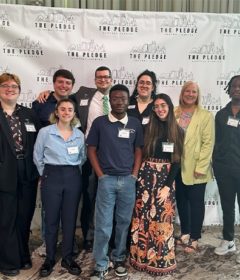Portrait of Stewardship
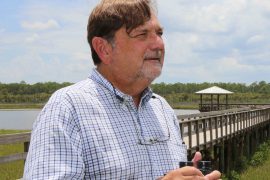
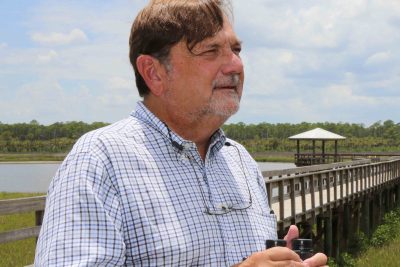
The narrow dirt road off of busy U.S. 1 leads visitors straight into the past.
It’s a world of thick pines, hardwoods and palms by a shoreline that overlooks the tranquil waters and mangrove islands of Spruce Creek. The more than 1,700 acres of public land look much like they did when American Indians and early European settlers fished, hunted and inhabited the area.
And today, thanks in large part to Clay Henderson ’77 — a noted conservationist, environmental lawyer and Stetson professor — Spruce Creek Park will be preserved for generations to come as a sanctuary from the bustling world of Port Orange and nearby New Smyrna Beach.
Henderson now heads the Stetson Institute for Water and Environmental Resilience, overseeing research that involves students, faculty and community leaders. Ultimately, the institute will provide policy options aimed at protecting natural resources, mostly in Central Florida.
For Henderson, it’s one final stop on a personal nature journey.
“I really want to get the institute up and going, and hand it off to someone when I am ready to retire. This is my last reinvention,” Henderson says, smiling.
The students primarily are environmental science majors, with their count increasing from eight students three years ago to 85 these days. The goal of the program is to teach students to better understand the connection between the science of ecology and public policy. “I hope these students go to work for agencies, even developers, giving them a better understanding of working with the environment,” Henderson adds.
He has reason to care.
PLEDGING ALLEGIANCE
Henderson has devoted his life to preserving the pristine lands and waterways of his youth, a respect of the past as a sixth-generation Floridian. He was born in North Florida, and his paternal grandmother passed along that love of nature, teaching him how to fish. Sunday dinner often was whatever she caught or shot.
“I could see Old Florida through her eyes,” Henderson says.
Little did he know then that it would provide the foundation for his future.
At 10, Henderson moved to New Smyrna Beach, not far from Stetson, after his father died and his mother landed a teaching job at Edgewater Elementary School.
Henderson was drawn to politics at a young age, and later majored in it and history at Stetson. While in college in the mid-1970s, he worked on Jimmy Carter’s presidential campaign in Florida. On the road, the two men often discussed their rural backgrounds and love of nature.
It was at that time that Henderson first heard the word “environmentalist” used to describe someone like himself. Soon after, he attended Cumberland School of Law in Alabama.
“I always wanted to go to law school, but I did not set out to be an environmental lawyer,” he notes. “I still was thinking politics.”
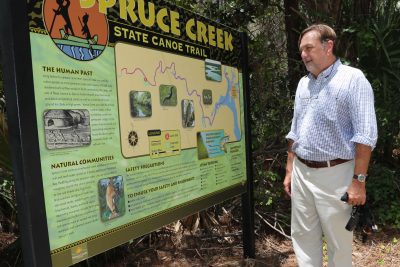
After passing The Florida Bar exam, he started his career as a lawyer in DeLand. He opened his own practice in 1980, the same year he married. His wife, Mary Jane Henderson, was a judge in Volusia County for 20 years.
The City of Edgewater hired him to help plan its first sewage plant and close the landfill that was leaching into the groundwater.
Henderson saw it as a challenge and a career opportunity, as a growing number of environmental laws were being passed in Washington, D.C. “I got in it at the right time, and over the years into many cutting-edge things,” he recounts. “I tried to solve problems, not create policy.”
MAKING A DIFFERENCE
More than three decades have passed since Henderson began working on saving land throughout Volusia County and Florida from development, with a goal of protecting wildlife and clean water, as well as providing recreational areas for fishing, boating and hiking.
“In 35 years, I’ve worked to preserve about 300,000 acres in Florida. I think my biggest success is being a part of developing some of the most successful land-preservation programs in the country, which have acquired more than 2.5 million acres over a 20-year period. Being on the ground floor was special,” Henderson says.
Standing on a long dock at Spruce Creek Park, Henderson, 62, laughs when recalling what the tract almost became, before the county reached an agreement with the previous owner to buy the land after voters approved a $20 million bond issue in 1986. That same year, he became a Volusia County Council member, serving until 1992.
“Every one of these pieces [of land] has a story,” he says, pointing. “This one involved a rich California family that was trying to get Jack Nicklaus to build a signature golf course. We found money to do it, buy up gems. I think we did all right.”
The land for Spruce Creek Park took on added significance by becoming the first endangered parcel in the nation bought with referendum-approved public money, a model widely duplicated by other government agencies across America.
“We didn’t know we were the first. It was just a practical solution,” says Henderson, who chaired the committee that oversaw the county program to buy land. “We needed money to get ahead of developers.”
Indeed, Henderson’s environmental résumé is long and impressive. After leaving the Volusia County Council, Henderson spent 15 years as senior counsel at Holland & Knight, a well-known national law firm in Orlando, where he specialized in land and water environmental issues. He also served for five years as president of the Florida Audubon Society and worked for The Nature Conservancy and the Trust for Public Land.
In 1998, he was appointed to then-Gov. Lawton Chiles’ Florida Constitution Revision Commission, sponsoring the majority of its environmental provisions. In 2014, he co-authored the state’s Water and Land Conservation Initiative (Amendment 1), the largest conservation funding program in United States history at $20 billion, which voters overwhelmingly approved.
Yet, such efforts haven’t been enough for Henderson and other environmentalists. They say the Florida Legislature has been slow putting the program into motion and allocating money for projects the voters want. The matter is being challenged in court by Henderson and others, maintaining that Florida is in violation of its own constitution.
“Little has been spent on land conservation. I think most politicians underestimate protecting [land and water],” Henderson says.
“There’s a disconnect that’s really philosophical. Our people all want to see a cleaner and better environment. They are users. Our elected officials aren’t. … It’s part of being a Floridian, protecting these very special places.”
Although his decades of work have quietly helped save a large piece of Old Florida, he isn’t satisfied. Daytona Beach News-Journal columnist Mark Lane, who has covered and commented on the region for parts of three decades, says Henderson has made a huge impact on the quality of life in Volusia County and the state.
“He was one of the few on the County Council who was forward-looking on the environment, a maverick,” Lane says. “Land preservation and water issues in the early years weren’t popular issues. Clay is someone who walks the walk. He gets out there on the water and in the woods. He’s not just a philosophical environmentalist.”
According to Pat Northey, who spent 20 years on the Volusia County Council, Henderson was instrumental in establishing the mindset for preserving endangered lands throughout this area — a major force for land and water conservation in the county and state.
“Clay’s work preserved the rural heart of Volusia County and protected it forever. Without his work, we would have been more suburban,” Northey comments. “The conservation corridor down the center of the county would have seen roadways and houses. Recreational and recharge lands wouldn’t be there without Clay.”
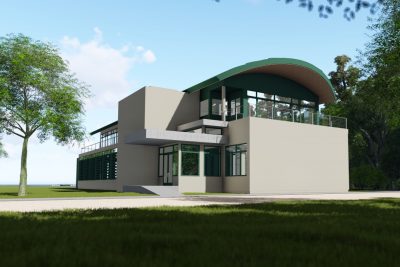
As for his newest role at Stetson, Northey says Henderson’s students are fortunate to have such a dedicated and demanding role model. “Clay holds people accountable. Those students will be taught well,” she says. “And he will expect good things from them as stewards of the environment in the future.”
David Hartgrove has known Henderson for 35 years, as vice president and conservation chair for the Halifax River Audubon Society in Daytona Beach, the oldest chapter in Volusia County.
“He’s certainly deeply committed, but he’s not so dogmatic in his views. With his political background, he knows you don’t get all you want. He knows how to compromise,” Hartgrove says. “His strength is compromising, picking up the phone to resolve a conflict, instead of shouting.”
Now, Henderson is passing on his vast body of knowledge to a younger generation at Stetson, which Hartgrove calls “a real love for him, by pouring his heart and soul into tackling water issues in Volusia, which are significant.”
“He has the [personal connections] to make something positive happen in that role as leader of the Institute,” Hartgrove adds.
LOOKING AHEAD
Henderson spends most of his time at Stetson now, building a program and a base of students and faculty. He continues to be a popular speaker at environmental events and fundraisers, alerting people that public environmental oversight remains critical. He warns that water quality and quantity are the big problems facing Florida in 2017, as more and more people put more and more demand on finite resources.
He remains vigilant.
“Most of our surface waters are deemed impaired, polluted in some way,” Henderson laments, citing places like Gemini Springs in DeBary, which has been closed to swimming for a decade because of bacteria. “We believe a large number of septic-tank nutrients made their way into the aquifer.”
Henderson adds that “Stetson is living what it preaches,” asserting that “all the water we use gets reused and put back in the aquifer.”
One day, Henderson vows, he will retire. He’d like to travel to places like the Amazon. For now, though, Florida steadfastly rests in his heart and mind.
“A lot of who I am today is from being a sixth-generation Floridian. I have a connection to this place,” he says.
And standing on the dock at Spruce Creek Park, Henderson knows the view would have been much different if he and his colleagues had failed. Maybe there would be a golf course or condos.
“This could have looked like everything else north and south of here,” he says, as a water bird soars over the mangroves. “What I love is driving down U.S. 1, passing by here at night, and it’s pitch-black. And all you see are the stars and the Ponce Inlet Lighthouse.”
-Ray Weiss
Note: This article appears in the Fall 2017 issue of Stetson University Magazine, with Clay Henderson, J.D., appearing on the cover.

